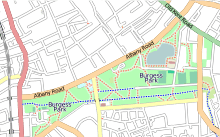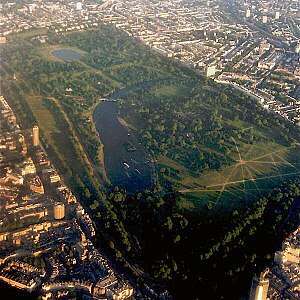Burgess Park
Burgess Park is a public park situated in the London Borough of Southwark, in an area between Camberwell to the west, Walworth to the north, Bermondsey to the east and Peckham to the south. At 56 hectares (140 acres), it is one of the largest parks in South London.[1]
.jpg)
Unlike most other parks in London, Burgess Park was carved out of a highly built-up area of the city. Virtually all the land now occupied by the park was previously used for housing, industry and transport infrastructure.
Construction


The idea for Burgess Park came out of the 1943 Abercrombie plan for open spaces in London, and the land has been gradually assembled and landscaped over the subsequent decades, first by the London County Council, then the Greater London Council, and since the mid-1980s, the London Borough of Southwark. The earliest component of what is now Burgess Park pre-dates the Abercrombie Plan. This is the King George's Field, opened in 1938 on the site of a former baths and swimming pool, at the Addington Square end of the park.[2]
An important stage in the construction of the park was the closure of the Grand Surrey Canal in the early 1970s, which terminated at Addington Wharf on Camberwell Road. The Canal served the Surrey Commercial Docks, and the area near Camberwell was full of 19th-century streets, houses and industrial buildings (including a R White's ginger beer factory and the Watkins Bible Factory[3]), many of which had suffered heavy bomb damage during WWII. The stretch of canal now incorporated in the park is the site of Camberwell Wharf, which was virtually straight. Other land incorporated in the park was occupied by housing. While some of this housing was in poor condition, a lot of perfectly serviceable homes were demolished to build the park, and this resulted in strong local feelings about the park.

Named Burgess Park in 1973 (after Councillor Jessie Burgess, Camberwell's first female Mayor), it is still incomplete and contains some former roads which have been stopped up but not yet grassed over. The boundaries of Burgess Park remain a matter of dispute, and because the park is unfinished, it is regularly the subject of proposals to build housing, schools, or transport links of the sort that would never be contemplated in one of London's older parks of Victorian origin.
Features

There are a large number of listed buildings in the Park, remnants of the streets which once occupied the site: an early 19th century lime kiln,[4] the Passmore Edwards library, baths and wash houses (the piers and railings of which are separately listed)[5][6] and the former almshouses in Chumleigh Gardens (which have three separate listings).[7][8][9] The whole of the Passmore Edwards building was listed as an asset of community value in 2014. The adjacent former church of St George designed by Francis Bedford, now converted into flats, is also listed; parts of its former churchyard form part of the park.[10] Its war memorial of Christ, head bowed, holding a crown of thorns, by the Danish artist Arild Rosenkrantz, is also listed.[11]
The library, baths and wash houses are occupied by a theatre group Theatre Delicatessen and by the Lynn AC boxing club.[12] An external wall has a large mosaic of a Camberwell Beauty butterfly. The almshouses are occupied by offices and by a café. There are also several bridges, which once used to cross the canal.
Chumleigh Gardens, near the centre of the park, is a World Garden, with plants and landscaping designed to reflect the diversity of the surrounding population of this highly cosmopolitan portion of London. It was established in 1995, in the grounds of the former Female Friendly Society Asylum.[13]
Recent additions to the park include Silent Raid, an art installation by Sally Hogarth commemorating Zeppelin raids on the local area in 1917[14] and a memorial to locally-born Jack Harvey VC.[15]
There is a thriving Friends of Burgess Park who also have an online heritage project on the park, Bridge To Nowhere. In the past, the park has played host to many festivals, including, in August, the Carnaval Del Pueblo, Europe's largest celebration of Latin American culture.
Facilities
In 2009, Burgess Park was one of 11 parks throughout Greater London chosen to receive money for redevelopment by a public vote. The park received a grant of £2 million from Boris Johnson, Mayor of London, as part of a London-wide competition, and the money was used to install better footpaths, additional lighting, refurbished public toilets and new play areas for children.[16] Subsequent plans existed to top this up to £6 million by Southwark Council, to ensure the renovation of the space.
Park facilities include a BMX track, tennis courts, football pitches, a rugby field (winter) / cricket oval (summer), a bbq area, a sports centre, a nursery, a community art project, Art in the Park, a local rugby club, Southwark Tigers, and two playgrounds.[17] The park hosts a Saturday morning 5 km ParkRun.[18]
References
- "Southwark Council Burgess Park". Southwark Council. 2013. Archived from the original on 29 August 2013. Retrieved 11 September 2013.
- "Friends of Burgess Park: Addington Square". www.bridgetonowhere.friendsofburgesspark.org.uk. Retrieved 2020-07-05.
- "Friends of Burgess Park: Watkins Bible Factory". www.bridgetonowhere.friendsofburgesspark.org.uk. Retrieved 2020-07-05.
- "National Heritage Listing Entry 1378394". historicengland.org.uk. Retrieved 2020-07-05.
- "National Heritage Listing Entry 1386038". historicengland.org.uk. Retrieved 2020-07-05.
- "National Heritage Listing Entry 1386039". historicengland.org.uk. Retrieved 2020-07-05.
- "National Heritage Listing Entry 1378481". historicengland.org.uk. Retrieved 2020-07-05.
- "National Heritage Listing Entry 1378480". historicengland.org.uk. Retrieved 2020-07-05.
- "National Heritage Listing Entry 1378482". historicengland.org.uk. Retrieved 2020-07-05.
- "Southwark Diocese Lost Church: St George, Camberwell" (PDF). southwark.anglican.org. Retrieved 2020-07-05.
- "National Heritage Listing Entry 1444721, where it is described as Burgess Park War Memorial". historicengland.org.uk. Retrieved 2020-07-05.
- "Friends of Burgess Park: Passmore Edwards Library". www.bridgetonowhere.friendsofburgesspark.org.uk. Retrieved 2020-07-05.
- "Friends of Burgess Park: Chumleigh Gardens". www.bridgetonowhere.friendsofburgesspark.org.uk. Retrieved 2020-07-05.
- "Friends of Burgess Park: Zeppelin 1917". www.friendsofburgesspark.org.uk. Retrieved 2020-07-05.
- "Southwark News article about the unveiling of the memorial to Jack Harvey VC". www.southwarknews.co.uk. Retrieved 2020-07-05.
- "London parks get £6m for revamp". BBC News. 4 March 2009. Retrieved 10 March 2009.
- "Southwark Council: Burgess Park". www.southwark.gov.uk. Retrieved 2020-07-05.
- "Burgess ParkRun". www.parkrun.org.uk/. Retrieved 2020-07-05.
External links
Further reading
- Charlesworth, Tim (2000). Story of Burgess Park. London: Groundwork Southwark. ISBN 978-0953750108.
